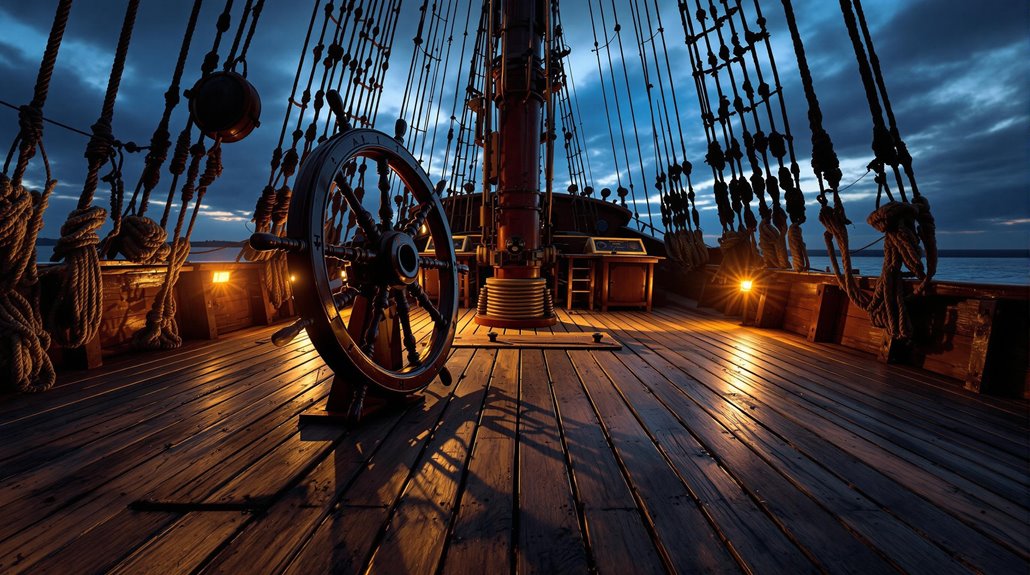The Amistad Revolt: Slaves Fighting for Freedom
You've likely heard of slave rebellions, but the Amistad Revolt stands apart as a remarkable demonstration of human courage and justice. When Joseph Cinqué and his fellow captives seized control of the Spanish schooner in 1839, they didn't just fight for their own freedom – they ignited a legal battle that would shake the foundations of American slavery. Their daring escape and subsequent trial would transform a simple cargo ship into a powerful symbol of resistance that still resonates today.
The Origins of La Amistad

While La Amistad wasn't built as a slave ship, this Spanish schooner became the setting of one of history's most significant slave revolts. At roughly 120 feet long, La Amistad's construction featured two masts, and under Ramón Ferrer's ownership, the vessel primarily transported sugar-industry products along the Cuban coast.
You'll find it interesting that La Amistad wasn't designed for human cargo – it lacked the purpose-built slave quarters common in dedicated slave ships. Instead, it was a merchant vessel that occasionally carried passengers.
In June 1839, the ship departed Havana with an illegal human cargo: 53 Mende captives from Sierra Leone. These Africans had been captured by slave catchers, sold to European traders, and transported to Cuba on the Portuguese ship Teçora, violating international treaties against the Atlantic slave trade. The lack of proper slave quarters meant the captives were placed in the main hold and on deck, which ultimately made their successful revolt possible. Their leader Sengbe Pieh, who became known as Joseph Cinque, would ultimately guide them to freedom.
The Spark of Rebellion
After enduring weeks of brutal captivity aboard La Amistad, the 53 enslaved Africans sparked a daring rebellion on July 2, 1839, near Cuba's coast. Under the leadership of Joseph Cinqué, their enslaved resistance transformed into a powerful uprising that would change their fate forever. These Africans had been abducted from Sierra Leone just months earlier, violating international treaties.
You can imagine the intensity of the maritime struggles as the events unfolded:
- Cinqué breaking free from his chains in the dark of night
- The rebels overpowering and killing the ship's cook and captain
- Desperate shouts echoing across the deck during the fight
- The navigator pleading for his life in exchange for guidance
- Freed captives taking control of the vessel's helm
The rebels spared the navigator's life, forcing him to sail toward Africa, though he'd secretly attempt to steer toward Cuba during nightfall. After two months at sea, the U.S. Navy intercepted and seized the ship off the coast of Long Island.
Navigation to Freedom
Despite their triumph in seizing control of La Amistad, the rebels faced intimidating navigational challenges during their bid for freedom.
You'll find that their limited sailing knowledge and unfamiliarity with ocean currents made the journey treacherous. They ordered the Spanish navigator to sail east toward Africa, but language barriers complicated their communication of desired navigation techniques.
For two months, the ship zigzagged along the coast, covering roughly 1,500 miles while making periodic stops for supplies. Under the leadership of Sengbe Pieh, the captives maintained control of the vessel while relying on their captive enslavers for navigation.
Though they encountered other vessels, they managed to evade capture. Their journey finally ended on August 26, 1839, when the U.S. brig Washington spotted them off Long Island. The U.S. Navy seized the ship and brought it to Connecticut for legal proceedings.
After 63 days and more than 2,000 miles at sea, they'd reached New London, Connecticut, where their arrival would ignite the abolitionist movement.
The Legal Battle Begins
The arrival of La Amistad in Connecticut waters sparked an immediate legal firestorm that would test America's judicial system.
You'll find the legal implications were immense as two parallel lawsuits emerged in federal and state courts.
While Spain demanded the return of what they called "slaves," the Van Buren administration couldn't interfere due to judicial independence.
The key moments that shaped this historic case include:
- Abolitionists citing the 1817 British-Spanish treaty banning slave trade
- Federal district court ruling the Africans were illegally captured free men
- Spain's diplomatic pressure forcing a government appeal
- John Quincy Adams coming out of retirement to defend the Africans
- Exposure of fraudulent Cuban documents falsely classifying the captives
You're witnessing how this case challenged America's stance on slavery while testing its commitment to justice.
Led by Joseph Cinqué, the 49 kidnapped Africans had taken control of the ship after killing the captain and cook in their desperate bid for freedom.
Murder charges were initially filed but later dropped as the focus shifted to property rights.
Supreme Court Showdown

When La Amistad finally reached the Supreme Court in 1841, a dramatic showdown unfolded between former President John Quincy Adams and U.S. Attorney General Henry D. Gilpin.
You'd witness the 72-year-old Adams, nearly blind but determined, arguing passionately for the Africans' freedom based on American ideals and legal precedents.
The U.S. government insisted on returning the captives to Spain, citing treaty obligations and Spanish property documents.
President Martin Van Buren and his administration actively undermined the judicial process to appease Southern political interests.
Abolitionists like Lewis Tappan provided crucial legal support by raising defense funds.
But Adams masterfully dismantled these arguments, emphasizing that illegally kidnapped Africans couldn't be considered property and had every right to fight for their freedom.
In a landmark 7-1 decision, the Supreme Court sided with Adams, declaring the Africans were free individuals who'd been unlawfully enslaved.
The Court ordered their immediate release, establishing a significant precedent in the fight against slavery.
Legacy and Historical Significance
Since its dramatic conclusion in 1841, the Amistad revolt has left an indelible mark on American history and the global fight against slavery.
The case's abolitionist impact strengthened anti-slavery networks and inspired new legal tactics to challenge the institution of slavery.











